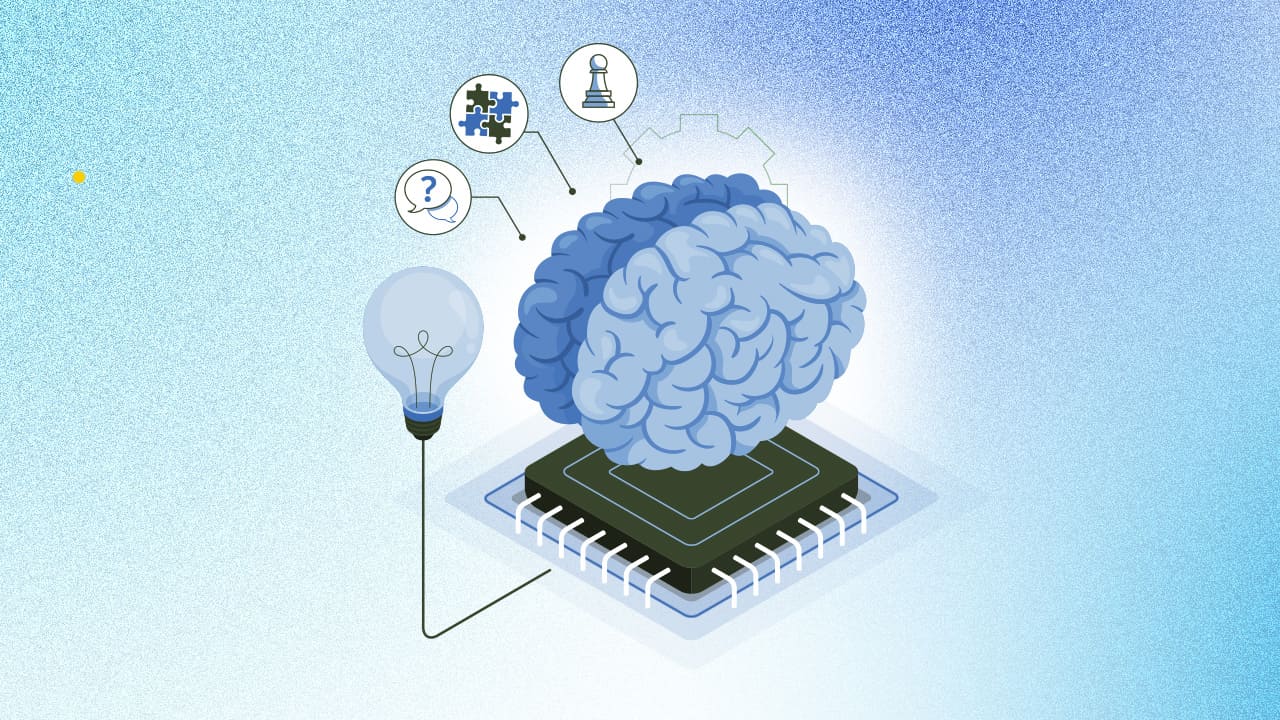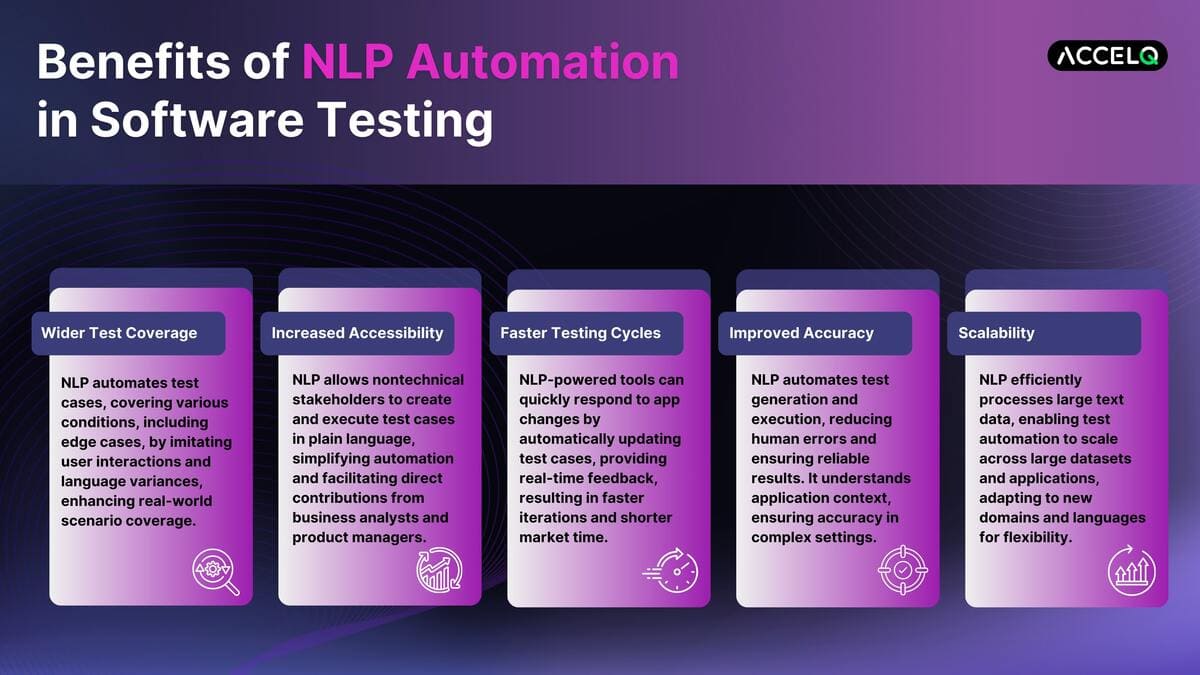NLP Test Automation: Shaping the Future of Software Testing

Understanding human language was a challenge for machines. But not anymore as Natural Language Processing (NLP) allows machines to understand, and respond to human language. With the growing adaptation of NLP in apps, the demand for effective test automation solutions has also increased. Let's look at NLP test automation, NLP components in test automation, its significance, key methodologies, and how it can enhance testing.
What is NLP?
NLP processes the interaction of computers and humans using natural language. It allows machines to interpret massive volumes of natural language data. Chatbots and sentiment analysis tools are popular examples of apps that rely on NLP.
What is the role of NLP Automation in Software Testing?
NLP test automation includes using automated testing tools and frameworks to test an app. It ensures that apps accurately understand, analyze, and respond to a variety of human inputs, including languages, dialects, and situations.
Key Features of NLP Automation in Software Testing:
- Text Parsing: Evaluates the system’s capabilities to parse and comprehend complicated phrases, idiomatic idioms, and domain-specific jargon.
- Sentiment Detection: Makes sure that the system correctly recognizes and categorizes sentiments in user inputs.
- Contextual Awareness: Makes sure that the system retains context throughout interactions, particularly multi-turn talks.
Why integrate NLP Components in Test Automation?
Integrating NLP components into test automation enhances the ability of testing systems to understand, process, and generate human language. Here’s how NLP components can be applied in test automation:
1. Test Case Generation
NLP may be used to translate natural language requirements into automated test cases. Identifying user stories or functional specifications in plain English allows NLP technologies to construct test cases, automatically decreasing manual labor.
2. Test Data Generation
NLP enables the generation of realistic test data from text descriptions. This makes it possible to create detailed test scenarios that closely resemble use cases found in the real world, ensuring a comprehensive evaluation of the app.
3. Test Case Execution
Test case execution using NLP automates software testing by understanding, running, and validating tests specified in natural language. This is particularly useful for testing conversational interfaces, voice-controlled apps, and other systems requiring spoken language interaction.
4. Test Result Analysis
Logs and error messages can also be analyzed using NLP. Understanding the context and meaning of the logs allows algorithms to categorize mistakes, identify central causes, and even suggest solutions. In applications where user input is critical, NLP may perform sentiment analysis on user reviews or comments to detect problems.
5. User Interface Testing
NLP can check UI text, such as labels and messages, against specified rules or expectations. This makes sure that the language used in the program is consistent with its planned design and functioning.
6. Enhancing Automation Scripts
By using NLP, automation scripts can be easily written in natural language, making them more readable and maintainable. This is especially valuable in situations where business analysts, who may be unfamiliar with coding, must understand or participate in the automation effort.
7. Intelligent Test Case Prioritization
NLP may assist in analyzing past test data and reported bugs. It needs to decide on the test cases that are more likely to identify faults, hence streamlining the testing process.
8. Documentation and Reporting
NLP can provide detailed reports and documentation, giving stakeholders clear insights in plain language.
Techniques for NLP Test Automation
| NLP Technique | Definition/Usage |
|---|---|
| Tokenization | Breaking down text into smaller units (tokens) such as words or sentences. |
| Lemmatization and Stemming | Condensing words to their most basic or root form. Lemmatization is condensing words using context and Stemming is condensing done using the root. |
| Part-of-Speech Tagging | Tagging each word in a sentence with nouns, verbs, etc. |
| Named Entity Recognition | Detecting and classifying key entities in a sentence. The entities can be predefined such as people, locations, etc. |
| Sentiment Analysis | Determining the emotional tone (positive, negative, neutral) expressed in text. |
| Word Embeddings | Vector representations of words capturing meanings based on context are used in various NLP tasks. |
| Topic Modeling | Discovering abstract topics within a collection of documents using algorithms like LDA. |
| Text Classification | Assigning predefined categories or labels to text based on content. |
| Text Summarization | Creating a shorter version of text that retains the most important information. |
| Machine Translation | Automatically translating text from one language to another, using models like NMT. |
| Dependency Parsing | Grammatically analyzing the sentence structure to determine relationships between words. |
| Coreference Resolution | Determining when two or more expressions refer to the same entity in a text. |
| Text Generation | Based on the input, create new, cohesive, and contextually relevant text. |
| Speech Recognition and Synthesis | Converting speech to text or text to speech for use in voice assistants and transcription services. |
Benefits of NLP Automation in Software Testing
1. Wider Test Coverage
NLP facilitates the automation of test cases that cover a broad range of conditions, including edge cases that might otherwise be neglected during human testing. Testers can develop tests that imitate genuine user interactions, including language variances, to improve coverage of real-world scenarios.
2. Increased Accessibility
NLP allows nontechnical stakeholders to write and run test cases in plain language, making test automation simpler to use to a wider audience. NLP lowers the barrier to participation in the testing process, helping business analysts, product managers, and others to make direct contributions.
3. Faster Testing Cycles
NLP can swiftly respond to app changes by automatically updating test cases, saving time. NLP-powered tools can carry out tests and offer feedback in real-time, resulting in faster iterations and a shorter time to market.
4. Improved Accuracy
Automating test generation and execution with NLP reduces the possibility of human errors, resulting in reliable and precise test results. NLP understands the context of the application being tested, ensuring that tests remain applicable and accurate, even in complicated settings.
5. Scalability
NLP can swiftly process and analyze massive amounts of text data, allowing test automation efforts to be scaled across big datasets and applications. NLP-powered test automation is easily adaptable to new domains and languages, making it highly scalable across different projects.
Challenges in NLP Test Automation
| Challenge | Description | Solution |
|---|---|---|
| Language Complexity | Human language can be unpredictable and highly variable. | Use Diverse Data Sets: Including different dialects, slang, and linguistic variations, to cover all possible scenarios. |
| Context Maintenance | Ensuring the NLP system maintains context in multi-turn conversations can be challenging. | Implement Continuous Testing: Regularly test the system’s ability to retain context across conversations, especially after updates or changes. |
| Handling Ambiguity | The systems may struggle with ambiguous language that can be interpreted in multiple ways. | Use AI Testing: Use AI to generate test cases that include ambiguous inputs, ensuring the system handles them appropriately. |
| Scalability Issues | As the complexity of the NLP application grows, maintaining testing efficiency becomes challenging. | Incorporate Performance Testing: Regularly conduct load and stress tests to ensure the NLP system scales effectively under increased demand. |
| Real-World Input Variability | Users may interact with the NLP system in unexpected ways, leading to potential misinterpretations. | Randomized Testing: Use randomized input testing to simulate unpredictable user interactions and ensure robust handling. |
Example of NLP Test Automation
This example shows how NLP test automation may be used with a sentiment analysis tool to ensure correctness and dependability in real-world circumstances. The method may be used to additional NLP applications such as chatbots, language translators, and text summaries.
Scenario: To Test a Sentiment Analysis Tool
Objective: To check that the tool correctly classifies texts as positive, negative, or neutral based on their emotions.
Step 1: Data Preparation-
- Positive Sentences: “I love this product!”, “The movie was fantastic!”
- Negative Sentences: “I hate waiting in line.”, “The service was terrible.”
- Neutral Sentences: “The weather is fine today.”, “I am going to the store.”
Step 2: Test Case Design
Data-Driven Testing:
- Input: Feed the prepared sentences into the sentiment analysis tool.
- Expected Output: Each sentence should be classified correctly as positive, negative, or neutral.
Step 3: Automation Execution
Use an Automation Framework: Implement the test cases using a framework like ACCELQ, which supports NLP integrations. Automate the feeding of sentences into the tool and capture the output.
Step 4: Validation
Compare Results:
- Automated Validation: The system compares the tool’s output with the expected sentiment for each sentence.
- Error Handling: If the tool’s classification doesn’t match the expected output, the test case is marked as failed.
Step 5: Reporting
A report is generated that highlights the success rate of the tool in classifying the sentiments. Include any failed test cases with details on the discrepancies between expected and actual results.
Step 6: Continuous Improvement
If errors are identified, they provide insights for refining the NLP model. Add more diverse and complex sentences to the test data to improve coverage in future tests.
Why ACCELQ?
NLP automation in software testing is critical to evaluating the dependability and performance of NLP-driven applications. As NLP technology advances, so will the methods for automating testing, making it a vital aspect of any testing program. If your business creates or maintains NLP-based apps, it's time to upgrade your testing skills with ACCELQ, our AI-powered test automation platform. It integrates smoothly with NLP, and provides a complete solution. Whether you need to automate chatbots, validate sentiment analysis tools, or ensure the contextual accuracy of your NLP systems, the platform provides the tools and flexibility you need. Explore ACCELQ today and transform the way you test applications!
Yuvarani Elankumaran
Technical Consultant at ACCELQ
Yuvarani Elankumaran is a highly skilled technical consultant at ACCELQ. With over a decade of experience in the field of Test Automation, Yuvarani is a seasoned professional who is well-versed in a variety of programming languages and automation frameworks.

































